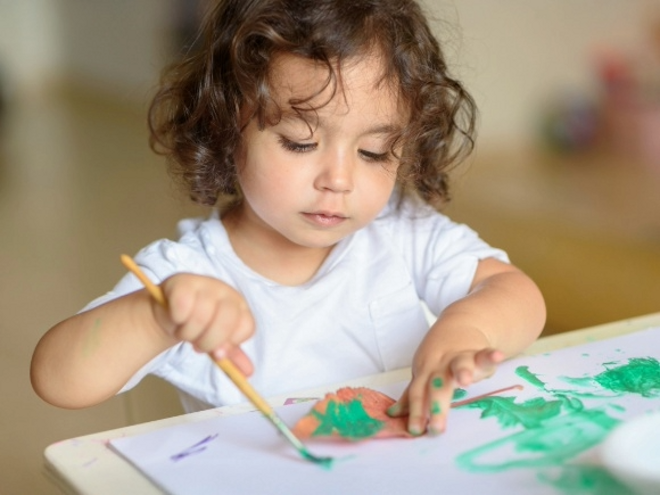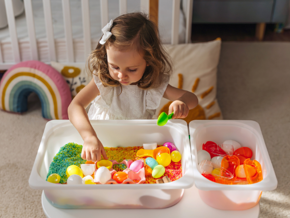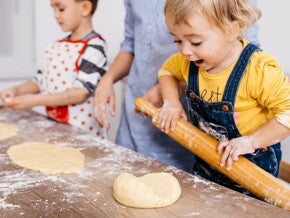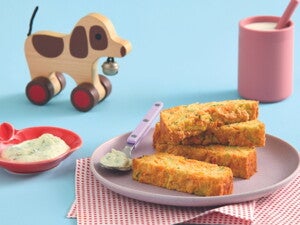
Fun and easy drawing ideas for preschoolers
Drawing is not only a fun and creative outlet for preschoolers but also a vital component of their overall development. Drawing benefits include enhancing fine motor skills, fostering creativity, and encouraging self-expression. In this article, we will explore these drawing benefits, share a collection of simple and fun drawing ideas, recommend basic supplies, and provide tips on how to nurture creativity at home.
What are the benefits of drawing for preschoolers?
Drawing is a fundamental part of early childhood development as it nurtures fine motor skills, creative thinking and concentration skills, which all help to support your child's growth and learning. Drawing with preschoolers serves as a form of expression, allowing them to communicate their thoughts, feelings, and experiences visually. As children explore colours, shapes, and lines, they lay the groundwork for future learning.
Fine motor skill development
One of the most significant benefits of drawing for preschool-aged children is the improvement of fine motor skills. As children grasp crayons, markers, or pencils, they practice hand-eye coordination and strengthen the small muscles in their hands and fingers. This skill development is vital for everyday tasks such as writing, buttoning clothes, and using utensils. Regular drawing activities help children refine their dexterity and control.
Creative thinking
Drawing with preschoolers encourages creative thinking, allowing them to explore their imagination and express their unique perspectives. When children create their own artwork, they learn to think outside the box and develop problem-solving skills. Arts and craft activities foster innovation and originality, as children experiment with different colours, shapes, and forms.
Concentration
Engaging in drawing activities also significantly boosts concentration levels in preschoolers. As children focus on their artwork, they learn to concentrate on tasks for extended periods, which is essential for their overall cognitive development. Attention skills help children develop patience and perseverance that are beneficial not only in artistic endeavours but also in academic settings.
Easy drawing ideas for preschoolers
As parents and caregivers, it's important to remember that children don’t need to be ‘good’ at drawing. What truly matters is the fun and exploration that comes from the creative process. Here are some simple drawing ideas that your little one can enjoy, even with limited skills or attention spans.
Drawing basic shapes and patterns
Start with basic shapes like circles, squares, and triangles. They can create patterns by repeating these shapes in different colours. This activity helps them understand geometry, shapes and angles.
Creating simple animal drawings
Animal drawings can be a great way for preschoolers to express their creativity. Start with simple animals like cats, dogs, or fish. Use basic shapes to guide them, such as circles for heads and ovals for bodies. This can be a fun way to incorporate storytelling as they create their favourite animals.
Observational drawing using everyday objects
Encourage your little one to look around the house or garden for inspiration. They can draw everyday objects like fruits, toys, or even clouds. Observational drawing helps them develop attention to detail and encourages them to see the world through an artist's eyes.
Hand tracing
Hand tracing is a fantastic activity that combines drawing with a bit of physical fun. Have your child place their hand on a piece of paper and trace around it. They can then decorate their handprint with colours, patterns, or even turn it into a character.
Colouring
Colouring is a classic activity that many preschoolers enjoy. Provide them with colouring books or print out colouring pages. This not only allows them to express their colour preferences but also helps improve their fine motor skills as they stay within the lines.
Letter drawing
Introduce your child to the letters of the alphabet by having them draw each letter. They can decorate the letters with colours and patterns, or even create small drawings that start with that letter. This activity combines art with literacy, making it educationally fun.
Self portraits
Encourage your child to create self-portraits. They can use mirrors to observe their features or simply draw from memory. This activity is a wonderful way for them to explore their identity and express how they see themselves.
Remember there are no right or wrong things to draw. Each child's creativity is unique, and it can be beneficial to try out different drawing activities to see what resonates with them.
What you need for drawing with preschoolers
A few basic supplies can go a long way in sparking creativity in preschoolers. Drawing is all about exploration and expression. You don’t need an extensive art studio to inspire your child's artistic side; a simple setup can provide endless opportunities for creativity. Here’s a list of materials that can make your drawing sessions enjoyable and engaging:
- Paper: Plain drawing paper, sketch pads, or even recycled paper can serve as a canvas for your child's imagination.
- Crayons: A box of crayons offers a variety of colours and is perfect for little hands to grip and use.
- Colouring books: These can provide inspiration and structure, allowing children to colour within outlines or create their own designs.
- Washable markers: These are great for bold colours and can be easily cleaned from surfaces, making them a parent-friendly option.
- Fun stickers: Stickers can add an element of fun to drawings, allowing children to embellish their artwork creatively.
- Pencils: Simple pencils can be used for sketching and are easy for preschoolers to control.
- Erasers: Having erasers on hand encourages children to experiment without fear of making mistakes.
Be mindful that a good drawing session can be successfully accomplished with just a pen and paper. The key is to encourage creativity and provide a space where children can express themselves freely.
How to encourage your preschooler to draw
You can play a vital role in helping your child feel confident and motivated to draw, even if they are initially hesitant. Encouraging your little one to engage in drawing can spark creativity and self-expression. Here are some effective tips to help inspire your child to pick up a pencil and start creating:
- Create a positive and supportive environment: Set up a dedicated space or art corner where your child can draw freely. Having a specific area with art supplies can make drawing feel special and inviting.
- Offer praise and encouragement for effort: Focus on praising your child's effort rather than the final outcome. Celebrate their creativity and the time they spend drawing, reinforcing the idea that the process is just as important as the finished piece.
- Allow freedom of expression: Encourage your child to express themselves without limitations. Let them choose what to draw and how to approach their artwork.
- Avoid correcting or restricting what they draw: Allow your little one to explore their imagination without boundaries, resist the urge to correct or guide your child’s drawings. This freedom can help them feel more confident in their abilities.
By implementing these strategies, you can help your preschooler develop a positive relationship with drawing, nurturing their creativity and self-confidence in the process. Remember, every child's artistic journey is unique, and your support can make all the difference! If your little one doesn’t have the concentration to focus on drawing yet, find some inspiration here on other outdoor toddler games to keep your little one active, instead.
Fun ways to make drawing part of everyday life
Drawing can be easily incorporated into daily routines and learning moments. Here are some ideas for integrating drawing into everyday life:
- Incorporate drawing into story time: After reading a story, invite your child to draw their favourite character or a memorable scene. This not only enhances their understanding of the story but also allows them to visualise and interpret the narrative in their own unique way.
- Use drawing as a learning tool: Transform learning into a fun activity by having your child draw things they are learning about at daycare or preschool like letters, shapes, or animals. This hands-on approach can reinforce their understanding and retention of new concepts while making learning enjoyable.
- Organise themed drawing activities: Plan themed drawing sessions based on holidays, seasons, or weather. For example, create holiday cards, draw seasonal scenes like autumn leaves or waves at the beach in summer, or illustrate sunny days and rainy weather. These activities can spark conversations about the themes and grow your child's understanding of the world around them.
By incorporating these fun drawing activities into your daily routines, you can help your little learner develop their artistic skills while making creativity an integral part of their everyday life.
Helping your preschooler grow through creativity
Drawing with your preschooler is a powerful activity that supports their growth in both fun and meaningful ways. It provides an avenue for children to express their thoughts and feelings, explore their creativity, and develop essential skills such as fine motor coordination and concentration.
As parents and caregivers, it’s important to embrace the mess that often comes with creativity. Celebrate the scribbles, the vibrant colours, and the imaginative creations that emerge from your child's hands.
Remember, the goal is not to achieve perfect drawings but to create drawing ideas for your preschooler that cultivates confidence, exploration, and self-expression. Each piece of art is a step in your child's journey of discovery, and the process of creating is what truly matters.
Frequently asked questions about drawing ideas for preschoolers
What should preschoolers be able to draw?
All kids develop at different rates, and have different interests so upfront it’s important to support your little one with encouragement and exploration as a priority over perfection and comparison to other kids. Starting with drawing basic shapes, such as circles, squares, and triangles, as well as simple representations of objects like animals, people, and their favourite characters, should be achievable. Their drawings may include scribbles and patterns, which are important for developing fine motor skills and creativity.
What is the easiest thing for kids to draw?
The easiest thing for kids to draw is often simple shapes, such as circles, squares, and triangles. These basic forms serve as building blocks for more complex drawings. Additionally, familiar objects like stick figures, smiley faces, and simple animals (like a cat or dog) are also easy and enjoyable for children to create. Encouraging them to draw what they know can boost their confidence and creativity.
How do you teach preschool drawings?
Teaching preschool drawings involves creating a supportive and engaging environment that encourages creativity and exploration. Some effective strategies may include providing basic materials (e.g. crayons, paper, paint); starting with basic shapes and then build on them; offer simple prompts (such as drawing their favourite animal) to help guide their direction and creativity; and provide plenty of encouragement, recognition of effort and celebration of their creations.
What shapes should a 4 year old be able to draw?
A 4-year-old should be able to draw basic shapes such as circles, squares, triangles, rectangles, and various lines, including straight, curved, and zigzag. Mastering these shapes may take time, and every kid will have their own pace to develop at. Honing these shapes will help your little one develop fine motor skills and lay the groundwork for more complex drawings as they continue to explore their creativity.
How to encourage a 3 year old to draw?
To encourage drawing for 3 year olds, provide a variety of safe and colourful art supplies, such as crayons and paper. Create a positive environment by joining them in drawing, offering praise for their efforts, and allowing freedom of expression. Make it fun by incorporating drawing into playtime and storytelling.






